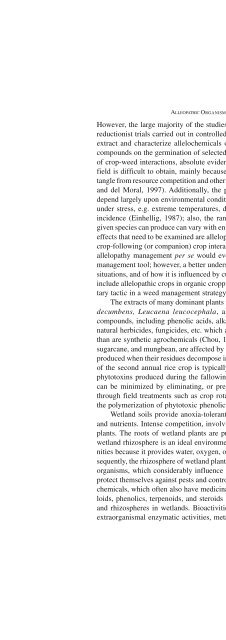Allelochemicals Biologica... - Name
Allelochemicals Biologica... - Name
Allelochemicals Biologica... - Name
You also want an ePaper? Increase the reach of your titles
YUMPU automatically turns print PDFs into web optimized ePapers that Google loves.
ALLEOPATHIC ORGANISMS AND<br />
MOLECULES<br />
However, the large majority of the studies carried out on this topic have referred to<br />
reductionist trials carried out in controlled environments, often with the only aim to<br />
extract and characterize allelochemicals or, at the most, to test the effect of these<br />
compounds on the germination of selected sensitive species in bioassays. In the case<br />
of crop-weed interactions, absolute evidence of the occurrence of allelopathy in the<br />
field is difficult to obtain, mainly because allelopathic effects are difficult to disentangle<br />
from resource competition and other biotic effects (Weidenhamer, 1996; Inderjit<br />
and del Moral, 1997). Additionally, the production and release of allelochemicals<br />
depend largely upon environmental conditions, usually being higher when plants are<br />
under stress, e.g. extreme temperatures, drought, soil nutrient deficiency, high pest<br />
incidence (Einhellig, 1987); also, the range and concentration of chemicals that a<br />
given species can produce can vary with environment conditions (Anaya, 1999). Other<br />
effects that need to be examined are allelopathy-mediated weed-weed, weed-crop and<br />
crop-following (or companion) crop interactions. It is therefore questionable whether<br />
allelopathy management per se would ever represent a consistently effective weed<br />
management tool; however, a better understanding of allelopathic occurrence in field<br />
situations, and of how it is influenced by cultural practices, would make it possible to<br />
include allelopathic crops in organic cropping systems and use them as a complementary<br />
tactic in a weed management strategy (Barberi, 2002).<br />
The extracts of many dominant plants in Taiwan, such as Delonix regia, Digitaria<br />
decumbens, Leucaena leucocephala, and Vitex negundo, contain allelopathic<br />
compounds, including phenolic acids, alkaloids, and flavonoids that can be used as<br />
natural herbicides, fungicides, etc. which are less disruptive of the global ecosystem<br />
than are synthetic agrochemicals (Chou, 1995). Many important crops, such as rice,<br />
sugarcane, and mungbean, are affected by their own toxic exudates or by phytotoxins<br />
produced when their residues decompose in the soil. For example, in Taiwan the yield<br />
of the second annual rice crop is typically 25% lower than that of the first, due to<br />
phytotoxins produced during the fallowing period between crops. Autointoxication<br />
can be minimized by eliminating, or preventing the formation of the phytotoxins<br />
through field treatments such as crop rotation, water draining, water flooding, and<br />
the polymerization of phytotoxic phenolics into a humic complex (Chou, 1995).<br />
Wetland soils provide anoxia-tolerant plants with access to ample light, water,<br />
and nutrients. Intense competition, involving chemical strategies, ensues among the<br />
plants. The roots of wetland plants are prime targets for root-eating pests, and the<br />
wetland rhizosphere is an ideal environment for many other organisms and communities<br />
because it provides water, oxygen, organic food, and physical protection. Consequently,<br />
the rhizosphere of wetland plants is densely populated by many specialized<br />
organisms, which considerably influence its biogeochemical functioning. The roots<br />
protect themselves against pests and control their rhizosphere organisms by bioactive<br />
chemicals, which often also have medicinal properties. Anaerobic metabolites, alkaloids,<br />
phenolics, terpenoids, and steroids are bioactive chemicals abundant in roots<br />
and rhizospheres in wetlands. Bioactivities include allelopathy, growth regulation,<br />
extraorganismal enzymatic activities, metal manipulation by phytosiderophores and<br />
35


